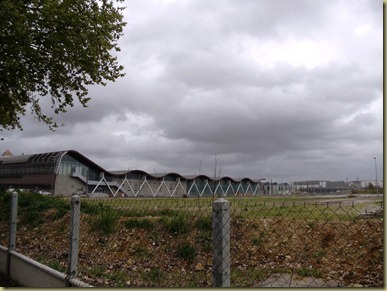 Divagando por internet, encontré que la oficina de turismo de Bordeaux ofrece unas visitas guiadas a los talleres del tranvía, que casualmente quedan en La Bastide. Oh, los sacrificios que hay que hacer por la investigación.
Divagando por internet, encontré que la oficina de turismo de Bordeaux ofrece unas visitas guiadas a los talleres del tranvía, que casualmente quedan en La Bastide. Oh, los sacrificios que hay que hacer por la investigación. En realidad estaba muy emocionada de ir a conocer las instalaciones de mi querido tranvía, que desde que llegué ha sido de las cosas que más me ha gustado de Bordeaux. No sólo porque el único transporte en común que conozco son los buses escolares en mal estado que los países del primer mundo vienen a botar a Honduras, sino porque el tranvía aquí es una pieza moderna y elegante de diseño contemporáneo que se desliza a diario en el centro histórico de la ciudad sin ningún contraste ofensivo. Todo lo contrario: con gran naturalidad, como si siempre hubiera estado allí, como si supiera que no tiene nada que envidiarle al prestigio de los edificios antiguos.
Yo creía saber todo del tranvía porque el año pasado leí un libro editado por Arc en rêve que publicaron para la exposición en 2003 que celebraba la inauguración de las tres líneas de tram. El tranvía fue diseñado por la agencia de arquitectura de Bordeaux Lanoire & Courrian, las estaciones y el mobiliario urbano por la diseñadora Elizabeth de Portzamparc (Esposa, hermana, hija o nada que ver con Christian?) y todo lo que es señalética por la agencia Brochet, Lajus & Pueyo, también arquitectos locales.
Tenía unas vagas nociones que este no es el primer tranvía de la ciudad. En el siglo XIX existía uno, que fue abandonado en 1960, cuando se remplazó por los buses. Por muchos años se discutió la posibilidad de instalar un metro en Bordeaux, pero al final no fue posible y se decidió mejor instalar un tranvía, que permitía la remodelación en superficie de los sectores que atravesaba. Se empezó a construir en 1997 y empezó a funcionar en 2003.
Wandering on the internet, I found out that Bordeaux’s tourism office offers guided tours to the tramway garages, which are very conveniently located at La Bastide. Oh the sacrifices that must be made for research.
Actually, I was very excited to visit the shops of my beloved tramway, one of my favorite things in Bordeaux. Not only because the only public transportation I know are used school buses that First-world countries send to Honduras when they are no longer safe or in good shape, but because the tramway here is a modern and elegant piece of contemporary design sliding through the city’s historical center without any offensive contrast. On the contrary: with such ease, as if it has always been there, as if it knew he has nothing to envy to the prestigious old buildings.
I thought I knew everything about the tramway because last year I read a book edited by Arc en rêve, published for the 2003 exhibit made in honor of the opening of the three tram lines. The tram was designed by architecture agency from Bordeaux Lanoire & Courrian; the stations and the street furniture by designer Elizabeth de Portzamparc (wife, sister, daughter or no relation to Christian?) and the signage were made by the agency Brochet, Lajus & Pueyo, also local architects.
I somewhat knew that this was not the city’s first tram. In the XIXth century there was one, abandoned in 1960 when it was replaced by buses. For many years, the possibility of building a subway in Bordeaux was discussed, but in the end it wasn’t possible and it was decided to install a tramway instead, which allowed the remodeling of the areas it crosses. Construction of the lines begun on 1997 and it started working on 2003.

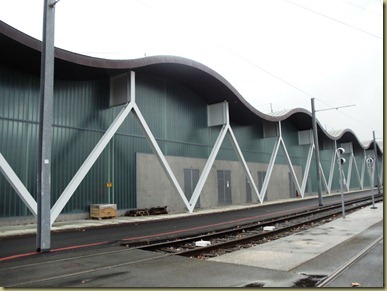
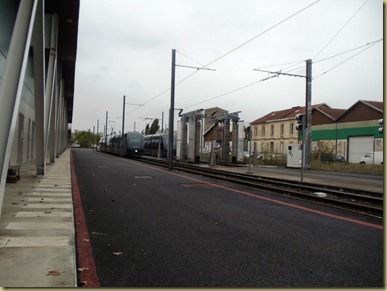
Creía saberlo todo, pero en esta visita aprendí muchas cosas. En primer lugar, actualmente hay aproximadamente 45 kilómetros de líneas de tranvía, que están previstas a ser ampliadas a 70 km, con la instalación de la línea D y la ampliación de la existente. Existe un depósito de tranvías en el sector de Bacalan, en el que no se puede hacer mantenimiento, sólo sirve de parqueo. Y se tiene planeado hacer otro en Bordeaux-Lac para el 2014. Por el momento circulan 77 unidades de tranvía que se espera que sean 100 dentro de dos años.
La característica más interesante del tranvía de Bordeaux es que tiene un sistema de alimentación por el suelo que se creó específicamente para que no hubiera cables que estorbaran la vista en el centro histórico. Este sistema cuesta tres veces más que la alimentación aérea tradicional y es por eso que sólo está en el centro y en la comuna de Talence, justo antes de llegar al campus universitario. Hay que señalar que a pesar que la corriente pasa por el suelo, no representa ningún riesgo porque sólo pasa electricidad cuando está en contacto con el vehículo.
Visitamos los talleres de los tranvías, diseñados por el arquitecto Jacques Ferrier. Son tres edificios: el primero tiene los talleres propiamente dicho y el puesto de control, el lugar donde se vigila toda la circulación de las unidades. El segundo es la estación de servicio, donde se conecta la unidad a un gran aspirador para limpiarla y el último donde se estacionan los vehículos al final del día. En el puesto de control hay personas trabajando las veinticuatro horas del día. En los primeros tres escritorios se encuentran los controladores de las tres líneas. Ellos revisan que los tranvías estén a tiempo y controlan la alimentación eléctrica en las líneas. La ubicación de todos los tranvías se puede ver en el gran tablero que tienen enfrente que tiene representadas las tres líneas con unos busitos amarillos si todo está bien, unos verdes si están adelantados y unos rojos si están retrasados. En el puesto de atrás está el encargado de la seguridad, que está en contacto con la policía, los bomberos o la ambulancia según sea necesario, además de la señora encargada de hacer los mensajes de voz que se transmiten en las estaciones y en las unidades en caso de perturbaciones.
I thought I knew everything, but in this visit I learned many things. First, there are approximately 45 km of tramway lines and with the opening of line D and the expansion of the existing ones, they will reach 100 km. There is another tramway garage in the Bacalan neighborhood, in which maintenance cannot be performed, it works just for parking. And it has been planned to build another one in Bordeaux-Lac for 2014. For the time being there are 77 tramway units but in two years they will be 100.
The interesting characteristic of Bordeaux’s tramway is that it has a floor power supply specifically created so that there wouldn’t be any cables ruining the view in the historical center. This system costs up to three times what traditional air power supply costs and that’s why it’s only installed in the center and in the Talence commune, just before reaching the university campus. It has to be said that even though power goes through the ground lines, it’s not risky at all because there is power only when the vehicle is in contact with the line.
We visited the tramway garages, designed by architect Jacques Ferrier. It has three buildings; the first one has the repair shops and the control room, where all units are looked after. The second one is the service station, where the unit is plugged into a huge vacuum in order to clean it and the last one is where the vehicles are parked at the end of the day. In the control room there is people working twenty-four hours a day. In the first three desks are the controllers for the three lines. They verify that tramways are on time and they can control the lines’ power supply. The localization of every single unit can be seen on the big board in front of them where the three lines are drawn. Yellow buses represent trams that are on time, green buses if they are in advance or red buses if they are late. In the back there is the person in charge of safety, who calls the police, the firemen or the ambulance according to what is needed, and that’s where you can find the lady who does the voice-over messages played in the units and the stations in case of disturbances.
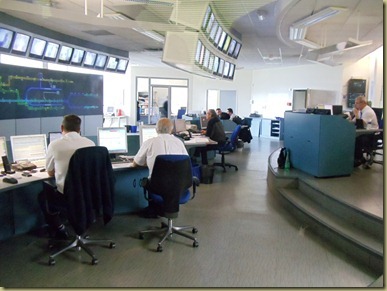
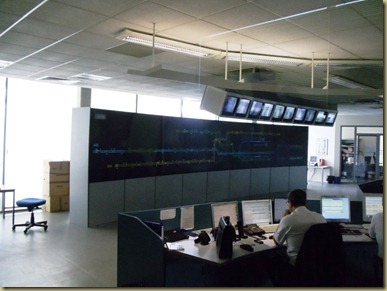
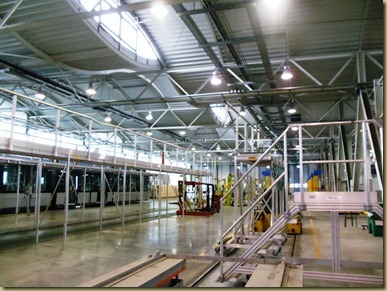
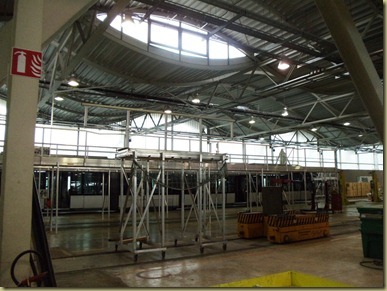

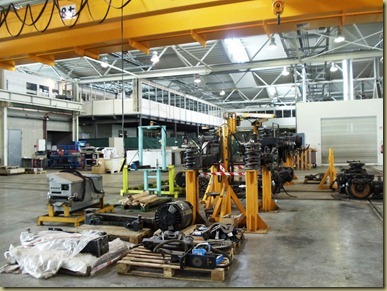
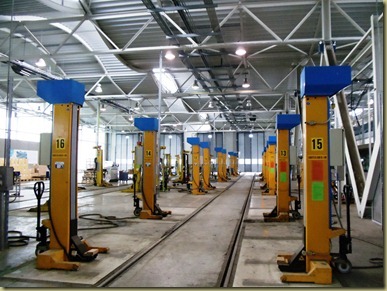
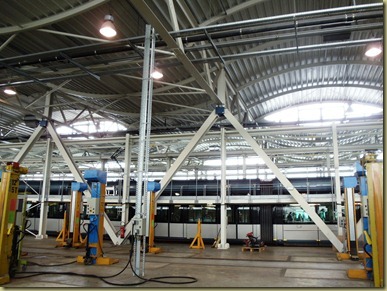
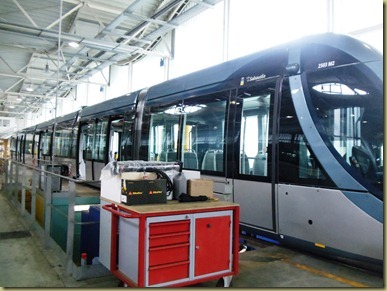
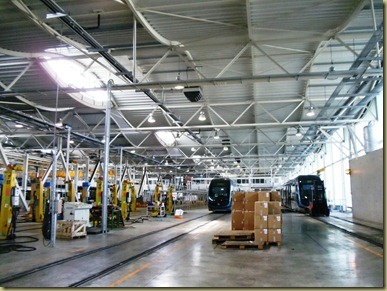
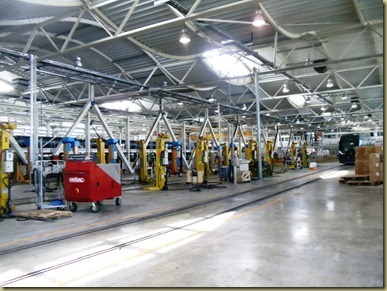
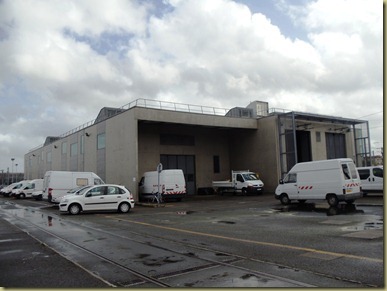
Al final de la visita nos subimos a un tranvía vacío, donde me senté en el puesto del conductor (hice un buen trabajo tratando de no desmayarme de la emoción). Nos explicaron cómo el conductor pone en movimiento el tranvía por una palanca a la que tiene que estar presionando constantemente, porque si no se acciona una alarma y se detiene el vehículo. Eso en caso de que se desmaye o que tenga algún otro problema. También los conductores tienen un pedal para activar la comunicación directa con el puesto de control, en caso de que tengan algún problema y quieran que escuchen todo lo que está pasando en la cabina del conductor, por si alguien intenta agredirlos, por ejemplo. Hay cámaras a lo largo del tranvía y cámaras que muestran lo que pasa en las estaciones.
La visita estuvo muy entretenida. Teníamos una guía de la oficina de turismo, para todo lo histórico y un controlador para todo lo técnico. El público me dio risa porque todos se estaban quejando de los defectos que tiene el sistema, más en funcionamiento que en diseño en realidad, como que por qué son tan poco frecuentes los tranvías el fin de semana, etc. Las instalaciones son magníficas y realmente vale la pena la visita. Y en el contexto de mi trabajo, puedo decir que este es el tipo de edificios que merece tener el barrio. En primer lugar porque su tipología no rompe con las actividades que se hacían en el lugar. La zona donde está instalado el edificio todavía alberga fábricas que se tiene previsto desalojar en los próximos años. El edificio es industrial pero tiene un aporte estético. Es contemporáneo pero también innovador, no es contemporáneo tímido, como otros edificios nuevos que se han construido en La Bastide. En fin, si dejo todo para hacerme conductora y controladora de tranvías, ya sabrán por qué fue.
At the end of the visit we got inside of an empty tram, where I sat in the driver’s seat (I did a good job trying not to faint of excitement). They explained to us that the driver sets the tram into motion with a stick which he has to push constantly. If he doesn’t an alarm sets off and the vehicle stops. This is in case he faints or he has any other problem. Also, the driver has a pedal that activates direct communication with the control room, in case he has an issue and wants people in there to listen to what is happening in the driver’s cabin. In case someone tries to hurt him, for example. There are also cameras all through the tram and cameras in the stations.
The visit was very entertaining. We had a guide from the tourism office, for everything historical and a controller for everything technical. I found the audience to be quite funny because everyone was complaining of the system’s defects, more of functioning than of design, such as why in the week-ends there are less trams, etc. The buildings are magnificent and the visit is definitely worth it. And in the context of my work, I can say that this is the kind of buildings the neighborhood deserves to have. First, because it has no conflict with the activities that took place there in the past. Actually, even now there are factories in the area but they plan on relocating them in the next few years. The building is industrial but it’s also quite beautiful. It’s contemporary and innovating, not shyly contemporary such as other buildings of La Bastide. Anyway, if I leave everything behind to become a tram driver and controller, you’ll know why.
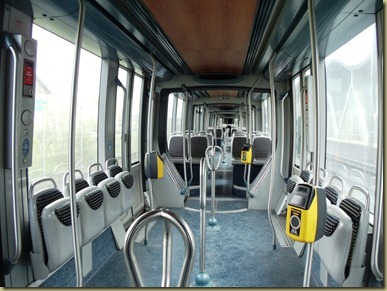

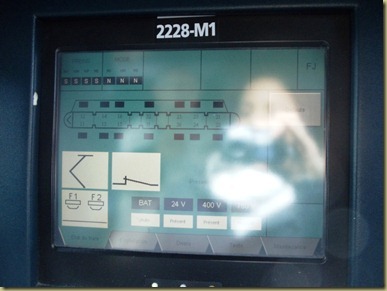
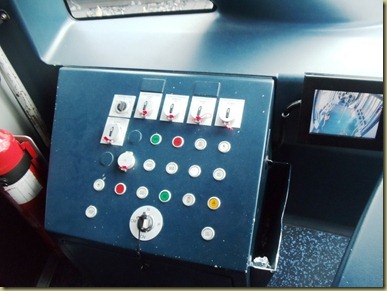
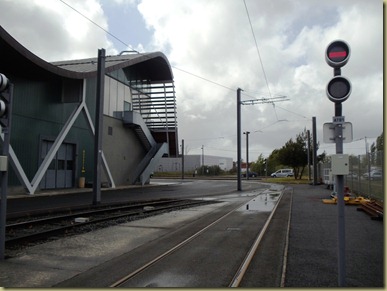

Post a Comment